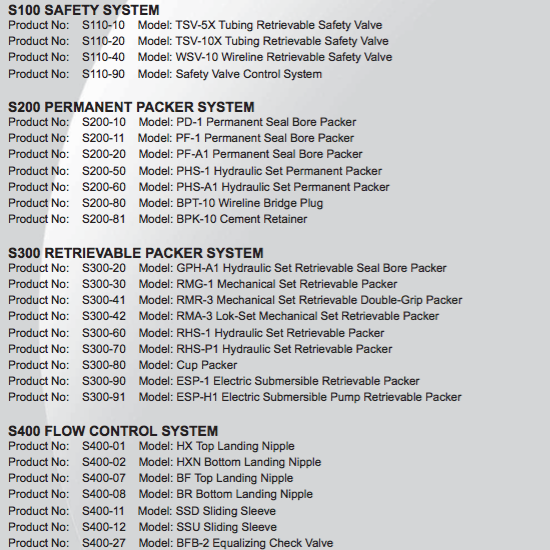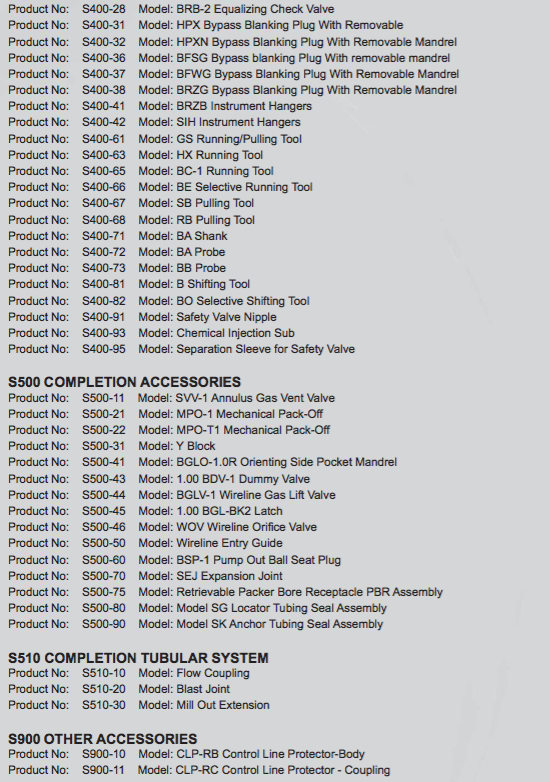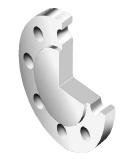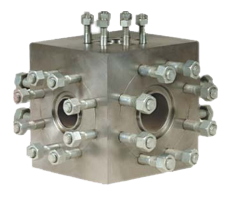
Wellhead and Downhole Tools
We provide a comprehensive line of technologically-advanced well completion line that includes completion products designed, prototyped and tested according to the oil and gas industry standards. These products include complete lines of Surface Controlled Subsurface Safety Valves Systems, Permanent and Retrievable Packers and Flow Control Equipment. We have specialized equipment like premium sand control screens and swell-able packers. We also have equipment for Multi-Stage Frac Systems.
Wellhead Products
Wellhead products for high-performance drilling and production.
Our experience, technical expertise and materials knowledge means you can depend on Keyser to deliver the wellhead solutions you need, when you need them. Through innovative technology and comprehensive service, our wellheads are designed to operate reliably to make your operations more efficient.
Our team of experienced Quality inspectors continually monitors the process from raw material sourcing through manufacturing, testing, and packing to ensure the delivered products meet your stringent requirements.
WS-22 / WS-29 Casing Heads have a straight bore bowl with 45 degree landing shoulder design which avoids damage to sealing areas by drilling tools and prevents test plug and bowl protector wedging problems when pressure is applied.
WS-22 / WS-29 Casing Heads are normally furnished with threaded outlets; studded outlets are available upon request. Bottom preparations can be furnished threaded or slip-on-weld.
WS-29 Casing Heads are based on the same reliable design as the WS-22 with exception that the bowl is deeper, which permits the acceptance of the WS-29 Casing Hanger with larger load capacity for deeper drilling.
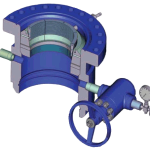
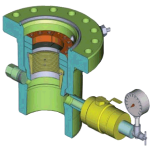
WS-22 / WS-29 Casing Spools have a straight bore bowl with 45 degree landing shoulder design. Bottom Prep can be PE/BG, “O-ring” bottom (below 5,000 psi applications) or double “P” seal bottom.
BG prep allows the use of reducer bushings “PE” (Pressure Energized). Outlets are normally threaded; studded / flanged outlets are available upon request.
WS-29 Casing Spools are based on the same design as the WS-22 with a deeper bowl which permits the acceptance of the WS-29 Casing Hanger with larger load capacity for deeper drilling.
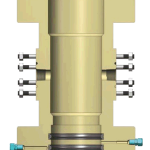
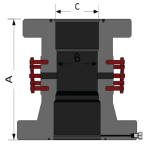
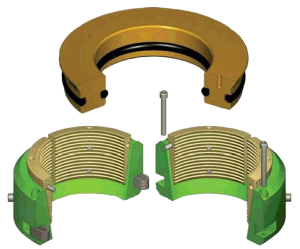
WS-21 Casing Hanger
WS-21 Casing Hanger combines slips, slip bowl and a type H pack off seal ring. The seal ring provides a positive annulus pack off after the casing has been suspended and cut off.
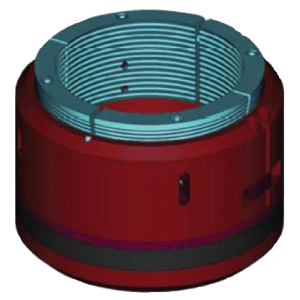
WS-22 Casing Hanger
WS-22 Casing Hanger is a wrap-around that incorporates pack off, slip bowl and slips. Pack off automatically seals the annulus below the slips when casing load is applied.
The WS-22 Hanger’s controlled friction reduces casing deflection. WS-22 casing hangers are easy to install and economical.
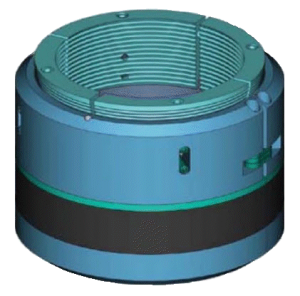
WS-29 Casing Hanger
WS-29 Casing Hanger provides a high hanging capacity with minimum casing deflection.
When the upper slips move down and energize the pack off, the WS-29‘s non-tapered lower slips engage automatically and apply controlled compression. The lower slips do not move down the pipe and thus do not create the high compressive forces seen in conventional tapered slips.
The WS-29 offers far less casing deflection and much greater hanging capacity than other conventional hangers.
WS-TCM Tubing Heads have straight bore bowl with 45 degree landing shoulders design which avoids damage to sealing areas by drilling tools and prevents wedging of tubing hangers, bowl protectors and test plugs. The secondary seal for the last casing pipe can be an integrated “PP” seal type or the plastic injection type, but also accepts reducer bushings “4-0” and “PE”.
The upper flange is supplied with lockdown screws for packoff re-energization and tubing hanger retention. The lower flange includes a grease fitting and orifice for testing of secondary seal.
WS-TCM Tubing Heads can be used for single completions and model TC is available for dual completions.
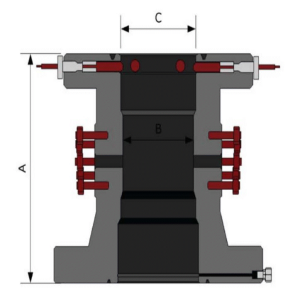
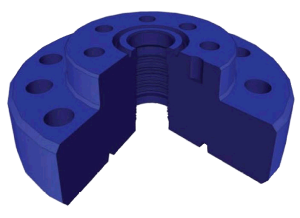
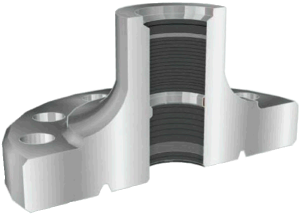
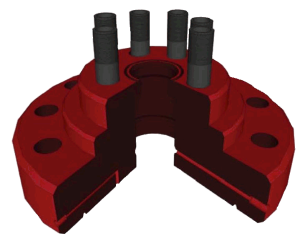
The tubing head adapter provides a transition between the Christmas tree and the tubing head. The bottom adapter connection matches the tubing head, and the top adapter connection matches the tree.
Tubing head adapters are available for all types of single- and multiple-string completions, including those using electric submersible pumps, packers, downhole control valves and gas lift valves. These adapters come with threaded, flanged or studded-flanged top connections.
Most tubing head adapters are available with hydraulic supply inlets for downhole control lines.
API 6A Flanged Slab Gate Valve
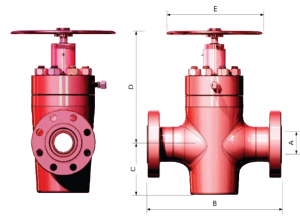
API 6A Threaded Slab Gate Valve
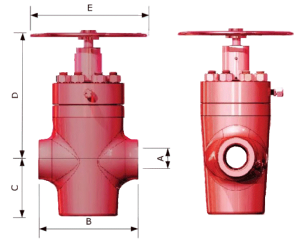
WS-FL, WS-FLS Flanged Slab Gate Valve is a high performance, bi-directional slab gate valve ideal for high pressure, critical service application 3,000 through 20,000 psi.
WS-FL, WS-FLS Threaded Slab Gate Valve is a high performance, bi-directional slab gate valve ideal for high pressure, critical service application 3,000 through 5,000 psi.
Standard Model WS-FL, WS-FLS gate valves utilizes a slab gate to meet the requirements of the latest edition of API 6A/API 6D SSV. Material for H2S service is in full accordance with latest edition of NACE MR-01-75.
API 6A Flanged Expanding Gate Valve
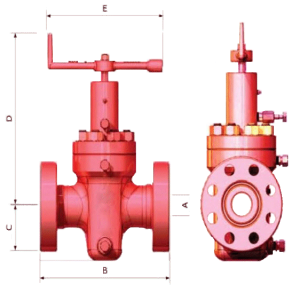
API 6A Threaded Expanding Gate Valve
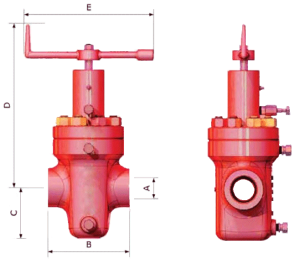
The WS-M expanding Gate Valve is bi-directional, with a preferred sealing side valve. For wellhead, production trees, and manifolds applications with working pressure rated at or below 5,000 psi.
The WS-BSO gate valve was designed for use as a manual valve in high-pressure, large bore applications.
- A ball screw mechanism and lower stem are incorporated into the WS-BSO gate valve to minimize the actuating torque.
- Bi-directional design provides flow direction flexibility and increased service life.
- Sealing at the gate-to-seat and seat-to-body is metal-to-metal.
- Two spring-loaded, pressure energized, non-elastomeric lip-seals provide maximum protection against intrusion of particle contaminants into the body cavity and seal areas, improving gate and seat service life, prevent damage to the body-to-seat seal face and improve valve performance at very low pressure.
- Lower stem balances pressure thrust on upper stem to reduce operating torque, prevents body cavity pressure build-up during operation and provides position indication.
- Spring-loaded, pressure energized, non-elastomeric stem seal covers full range of pressures, temperatures, and fluids.
- Pressure-energized metal-to-metal bonnet seal.
- Either stem can be back seated to allow stem seal replacement with
valve under pressure. - Grease injection fittings located on the downstream side of the stem and the balancing stem backseat for safety.
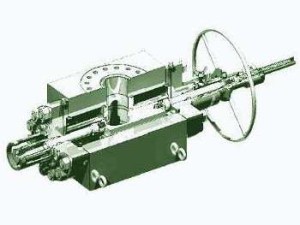
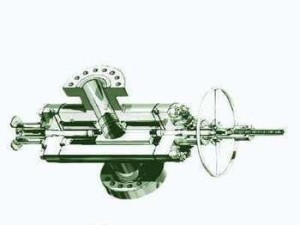
Christmas Tree Cap
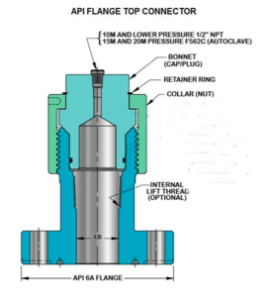
Valve-Removal Plug
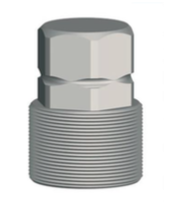
Bull plugs
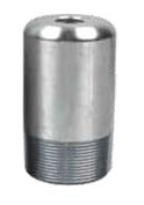
- Manufactured Per ISO 10423 Standard and API 6A Specification.
- Otis Style.
- 11-AO And 15-A
- Comes With Or Without Lift Thread.
- Manufactured Per ISO 10423 and API 6A Specification.
- 2,000 to 20,000 psi Pressure Rating.
- Manufactured Per ISO 10423 and API 6A Specification.
- Hardness Testing
- Ultrasonic Testing
- QTC Control
- CMM Inspection
- Tensile Test Equipment
- Impact Test Equipment
- Chemical Composition Analyser
- Metalloscope
- King Tester
- Rockwell Tester
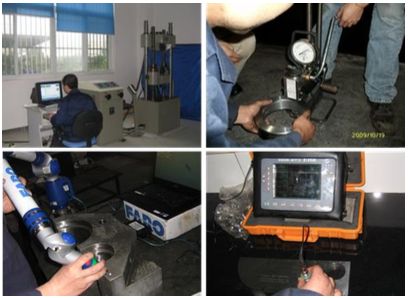
Downhole Tools
Single Zone Completions Design
Retrievable Packer System


Normally, single zone completions of oil and gas wells allow relative simplicity in the completion design. In the most basic of these completions, absent of significant bottom hole pressure and temperatures, the completion might include only a tubing anchoring device or basic packer to accommodate casing protection or artificial lift equipment.
The complexity of a single zone completion is dictated, not only by the producing zones pressure, temperature, and fluid/gas characteristics but also by the proposed setting technique and anticipated treatment activities. Properly designed, the completion can be installed as designed, and not require removal or redesign for planned treatment of the zone.
For this reason, a broad range of tool designs exist to provide the options necessary, both for the wellbore conditions and the economic considerations of the well.
Completions, which may require installation removal for either maintenance or changing well conditions, typically employ retrievable packers.
Permanent packers are usually selected for more extreme conditions and where well conditions may remain stable for longer periods.
With either selection, setting options are determined by the well conditions and well site considerations. While retrievable packers are available in mechanical set, hydraulic set, or wireline set models, permanent packers are normally set on wireline or hydraulically actuated.
Other accesory components of the completion, including flow control devices and safety systems, must also be designed into the completion to accommodate both existing and anticipated conditions.
A surface controlled sub-surface safety valve is used as an integral part of the tubing string in production or injection wells. The Sub-Surface Safety Valves are used to provide a downhole safety valve meeting regulatory requirements. A sub-surface safety valve capable, of shutting in the well is utilized to protect people’s lives, properties, the operator’s investment, and the environment in the event of a catastrophe at the surface.
Single String Completion Design
Seal Bore Packer System


This Hook-up unitizing the Seal Bore Packer completion is a common and simple means of completing a well with built-in versatility and flexibility.
Seal Bore Packers are usually selected for more extreme conditions and where well conditions may remain stable for longer periods.
Seal Bore Packers, permit large full-bore flow passages. The completion tubing string can be positioned into the seal bore packer in two ways.
A locator tubing seal assembly provides a high pressure seal between the packers and tubing that allows upward tubing movement of the seals during well operations. The inclusion of extra tubing seal units below a locator, as shown in the accompanying hookup drawing, compensates for tubing movement by traveling through the packer bore and the Seal Bore Extension. The proper length of the Seal Bore Extension required can be calculated by using the Tube Movement Program and considering all life of well activities.
Alternatively, an Anchor Tubing Seal Assembly can be used in place of the locator. The anchor attaches the tubing string to the packer restricting motion of the seals and transmitting tubing forces through the packer to the casing. The anchor is released by right-hand rotation. The packer and tailpipe assembly are run in and set either on wireline or tubing with a setting tool. Utilization of a packer attached tailpipe permits blanked-off retrieval of tubing eliminating possible formation damage due to kills fluids.
Both scenarios permit through-tubing perforation under pressure for safety and flanged up displacement of well fluid through the sliding sleeve. Pressure and temperature recording instruments can be set in the lower seating nipple without restricting the flow path. Protection for the instruments from flow turbulence and vibration can be provided by a spacer tube below the seating nipple or Flow Couplings are recommended based on individual conditions.
The bottom zone formation can be blanked off at the Seating Nipple above the perforated spacer tube.
Subsurface Safety Valves can be installed on completion string to provide the automatic shut-in of the well in the event of a catastrophe at surface, damaging X-tree or tubing strings above the packer, as required in offshore completions.
Single String Completion Design
Hydraulic Set Permanent Packer System


This completion was designed for high pressure/high temperature, oil and gas production in an offshore environment.
The design is simple, robust, reliable completion that would provide flexibility throughout the life of the reservoir and minimize rig time.
Key factors in the selection of the completion components included: reliability, single trip installation, and regulatory compliance.
A Hydraulic Set Permanent Packer is employed to minimize installation time and to allow a greater margin of safety by installing the wellhead before the packer is set. The flanged up wellhead providing exceptional well control while displacing or circulating downhole fluids
Hydraulic Set Permanent Packers are installed on the production tubing eliminating a separate setting tool trip and greatly simplifying space-out procedures.
In areas and environments with high rig costs, hydraulically setting the production packer will save time and greatly reduce the complexity of the completion.
This completion was also designed to accommodate a large bore, high- pressure, hydraulic fracture treatment. The operator re-completed a lower zone after the upper zone watered out with the squeezed-off upper zone limiting the annulus pressure that could be applied during the fracture treatment.
An Anchor Tubing Seal Assembly can be used in place. The anchor attaches the tubing string to the packer restricting motion of the seals and transmitting tubing forces through the packer to the casing. The anchor is released by right-hand rotation.
An Expansion Joint is utilized to compensate for tubing movement; circulation of well fluid through the Sliding Sleeve can be performed with the well head in place.
The completion is easily adapted for deployment under pressure by employing a blanking plug in the tailpipe or retrieval of tubing eliminating possible formation damage due to kill fluids.
Subsurface Safety Valves can be installed on completion string to provide the automatic shut-in of the well in the event of a catastrophe at surface, damaging X-tree or tubing strings above the packer, as required in offshore completions.
Single String Completion Design
Retrievable Packer With Chemical Injection System


When the completion is desirable to flange up the wellhead prior to setting the packer or where there is concern about the ability to get rotation to the packer, hydraulic set packers are used to complete the well. Completions with hydraulic set packers include a means of temporarily plugging the tubing, typically a wireline entry guide with pump out plug or ball seat for a drop ball, or a seating nipple for use with a wireline retrievable plug.
Pump pressure applied down the tubing string provides actuation of the packer’s setting mechanism. These packers can be either permanent or retrievable design. The retrievable versions normally include a shear release mechanism requiring only straight pull on the packer or rotation.
The completion design must consider potential forces acting on the shear release ring particularly when future well treatments are expected.
An Expansion Joint is utilized to compensate for tubing movement; circulation of well fluid through the Sliding Sleeve can be performed with the well head in place.
The Chemical Injection Systems offers downhole continuous injection that is a tried and proven method to treat your wells for the prevention of downhole corrosion, scale, paraffin, emulsion and hydrates. No exotic tubing or high priced completions are required when using our injection lines in your completions.
The simple method used to install the chemical injection line is safe and fast when running your production string.
An injection line from the surface to the chemical injection mandrel allows precise control of the injected chemical. The chemical remains fresh and uncontaminated. It allows precise control the chemical injection rate, rapid switching out chemicals.
A configuration also allows the Injection below the packer is also available. The bottom zone formation can be blanked off at the Seating Nipple above the perforated spacer tube.
Pressure and temperature recording instruments can be set in the lower seating nipple without interference the flow path. Protection for the instruments from flow turbulence and vibration can be provided by a spacer tube below the seating nipple or Flow Couplings are recommended based on individual conditions.
Subsurface Safety Valves can be installed on completion string to provide the automatic shut-in of the well in the event of a catastrophe at surface, damaging X-tree or tubing strings above the packer, as required in offshore completions. This system provides for single trip retrievable of the entire completion system.
Multi-Zone Completions Design


All oil and gas wells with completions designed to address two or more zones of interest involve several issues requiring detailed review for a satisfactory completion design. Not only must the completion design address the characteristics of the well’s producing zones, but it must also address issues of selectivity and ensure compatibility of all devices making up the completion.
The completion must not only be evaluated as it stands, but also in consideration of the run in and setting procedures. Well bore pressures, temperature, tool setting, tool movements, tubing movements, rotational limitations, and landing are all among the necessary considerations. Multi-zone completions might involve only single string packers or a combination of dual string packers, depending on the producing and isolation requirements.
In addition, flow control equipment is normally necessary for tool setting and testing as well as selective flow and circulation. It is important that all flow control equipment be carefully selected to meet production specifications and profile compatibility.
Similar to flow control equipment, the selection of subsurface safety equipment must be selected in consideration of the entire system and run in procedures. The safety valve can incorporate the same selective profiles as the flow control equipment, which provides virtually unlimited flow control positioning options with no additional restrictions to the ID.
Issues of space out, tubing movement, and body movement are increasingly important as the complexity of the completion increases with multiple zones and more extreme conditions. Packer selection might include all retrievable, all permanent, or a combination of retrievable and permanent models.
Regardless of the specific design criteria for a given Multi-zone Completion, it is most important that the design be developed as a "SYSTEM", both for the well’s planned operation and the ability to successfully put the system in place. Cooperative detailed planning between the operator and Service Company well in advance of the installation is the key to the success of complex Multi-zone Completions.
This Single String Selective Completion design allows for a single trip flanged up completion utilizing Tubing Retrievable Hydraulic Packers along with sliding sleeves.
The completion allows for commingling of zones or separate production, isolation, testing, or stimulation of individual zones. Selectivity is accomplished by opening and closing sliding sleeves between the packers.
Circulation of well fluid through the Top Sliding Sleeve can be performed with the well head in place.
If selective set hydraulic set retrievable packers are utilized, then each packer can be selectively set and individually tested to ensure proper isolation between zones. Blast joints located adjacent to producing zones resist the erosive forces of the produced fluids
The bottom zone formation can be blanked off at the Seating Nipple above the perforated spacer tube.
Pressure and temperature recording instruments can be set in the lower seating nipple without interference the flow path. Protection for the instruments from flow turbulence and vibration can be provided by a spacer tube below the seating nipple or Flow Couplings are recommended based on individual conditions.
Subsurface Safety Valves can be installed on completion string to provide the automatic shut-in of the well in the event of a catastrophe at surface, damaging X-tree or tubing strings above the packer, as required in offshore completions.
This system provides for single trip retrievable of the entire completion system.
Multi-Zone Completion Design
Dual Strings Completion System


Multi-Zone completions that are subject to cross flow or prohibited from commingled production can be designed for One-Trip installation.
Multi-Zone completions can be addressed with both flexibility and long term economics incorporated into the design. The use of both dual and single string hydraulic set retrievable packers provides for setting of all the packers following installation of the tree.
Multiple pay zones can be perforated in the initial completion procedures, and then isolated as desired without requiring future rig intervention.
The production string allows wireline access to the formation for logging and monitoring purposes is desired.
In the event of a workover, a wireline blanking plug can be set below the packer to maintain well control.
Hydraulic set packers permit flanged up setting. Seating nipples positioned below each packer provide for the temporary plugging required for setting of the packer or as required through the life of the well.
Pump pressure applied down the tubing string provides actuation of the packer’s setting mechanism.
The Packer is normally included a shear release mechanism requiring only straight pull on the packer to release the completion string.
The completion design must consider potential forces acting on the shear release ring particularly when future well treatments are expected.
A sliding sleeve, positioned on the long string above the lower packer, provides for circulation or spotting of fluids for upper zone treatment or the option of producing the upper zone through the long string.
Subsurface Safety Valves can be installed on both completion strings to provide the automatic shut-in of the well in the event of a catastrophe at surface, damaging X-tree or tubing strings above the packer, as required in offshore. This type of completion configuration offers long term flexibility for changing well conditions while providing a completely retrievable completion system.
ESP Completion Design


Electric Submersible Pump (ESP) completions are an alternative means of obtaining artificial lift in wells that have low bottom hole pressures. ESP completions are the most efficient choice for high volume capable wells.
In its most basic form, the ESP completion is a pump powered by a coupled electric motor suspended downhole on a tubing string. The pump receives power from a cable secured to the exterior of the tubing. Surface facilities require only a power transformer and a switchboard.
Due to these minimal surface requirements, ESP’s are a popular choice for space limited applications such as offshore facilities. They are also used in locations where a large quantity of pressurized gas is not available for a gas lift system. There are some drawbacks to the ESP. The primary concern is the limited operational life of these complicated mechanisms. The pump itself is a centrifugal type that can be damaged by solids or debris.
Protective shrouds are used over the fluid intakes to prevent this from occuring. The natural cavitations from the pump releases gas from the produced fluid into the annulus. Exposure to large volumes of free gas can cause wear damage as well as potential overheating.
ESP packers with feed-through capability are used and accommodate the power cable as a second string.
Additional penetrations through the ESP Packer can allow chemical injection, gauge data lines, and gas venting. A surface controlled valve integral to the packer can be used to control the venting of the free gas up the annulus. Thus, well control is maintained reducing operational risks. Packers are also commonly used to protect the casing from corrosive chemicals within the produced fluid.
In conventional ESP Applications, the Hydraulic Set ESP Packer performs the function of thru tubing hanger and a well control device. If gas is present during production, a Gas Vent Valve can be mounted in a vent port in the packer to reduce the volume of free gas produced through the pump, which increases efficiency. The second string packer bore is fitted with a cable packoff device and accommodates passage of the ESP power cable. Circulation above or below the packer is accomplished through a sliding sleeve or through the Gas Vent Valve.
In many applications, a standing valve is placed above the pump to prevent back-flow when the pump is turned off, preventing possible damage to the pump when the motor is restarted.
This standing valve is also act as a setting device to the tubing to set the ESP Packer or a temporarily plugging the tubing like the seating nipple for use with the wireline retrievable plug.
Pump pressure applied down the tubing string provides actuation of the packer’s setting mechanism.
The Retrievable ESP Packer is normally included a shear release mechanism requiring only straight pull on the packer to release the completion string.
The completion design must consider potential forces acting on the shear release ring particularly when future well treatments are expected.
The Chemical Injection Systems offers downhole continuous injection that is a tried and proven method to treat your wells for the prevention of downhole corrosion, scale, paraffin, emulsion and hydrates. No exotic tubing or high priced completions are required when using our injection lines in your completions.
The simple method used to install the chemical injection line is safe and fast when running your production string.
An injection line from the surface to the chemical injection mandrel allows precise control of the injected chemical. The chemical remains fresh and uncontaminated. It allows precise control the chemical injection rate, rapid switching out chemicals.
Subsurface Safety Valves can be installed on completion string to provide the automatic shut-in of the well in the event of a catastrophe at surface, damaging X-tree or tubing strings above the packer, as required in offshore completions. This system provides for single trip retrievable of the entire completion system.
ESP Multi-Zone Completions Design – Y Block System


In conventional ESP Applications, the Hydraulic Set ESP Packer performs the function of thru tubing hanger and a well control device. If gas is present during production, a Gas Vent Valve can be mounted in a vent port in the packer to reduce the volume of free gas produced through the pump, which increases efficiency. The second string packer bore is fitted with a cable packoff device and accommodates passage of the ESP power cable. Circulation above or below the packer is accomplished through a sliding sleeve or through the Gas Vent Valve.
Very common ESP pump completion ivolves a formation that will flow naturally, but where kill weight fluids would damage the formation during a workover. Wireline access to the formation for logging and monitoring purposes is desired.
The Y-Block in the production string allows wireline access below the pump and motor assembly through the tubing for these purposes. In the event of a workover, a wireline blanking plug can be set below the seal bore packer to maintain well control while the upper section of the completion is removed from the well.
The production normally flows from the producing formation below the seal bore packer, through the sliding sleeve, and into the annulus and pump inlet. If desired, the sleeve can be closed to permit direct production from the formation to the surface, bypassing the pump.
In certain applications, it is desired to monitor the well continuously. Optional feed-thru passages in the ESP Packer can facilitate running of downhole gauges. The ESP Packer is hydraulic set, a temporarily plugging the tubing like the seating nipple for use with the wireline retrievable plug. Pump pressure applied down the tubing string provides actuation of the packer’s setting mechanism.
The Retrievable ESP Packer is normally included a shear release mechanism requiring only straight pull on the packer to release the completion string. The completion design must consider potential forces acting on the shear release ring particularly when future well treatments are expected. The Chemical Injection Systems offers downhole continuous injection that is a tried and proven method to treat your wells for the prevention of downhole corrosion, scale, parrafin, emulsion and hydrates. No exoting tubing or high priced completions are required when using our injection lines in your completions.
The simple method used to install the chemical injection line is safe and fast when running your production string.
An injection line from the surface to the chemical injection mandrel allows precise control of the injected chemical. The chemical remains fresh and uncontaminated. It allows precise control the chemical injection rate, rapid switching out chemicals.
Subsurface Safety Valves can be installed on completion string to provide the automatic shut-in of the well in the event of a catastrophe at surface, damaging X-tree or tubing strings above the packer, as required in offshore completions.
This system provides for single trip retrievable of the entire completion system above the Seal Bore Packer.
Monobore Liner Top Completion Solutions
(Locator Seal System)


Monobore completions are gaining favor in many applications. Although basic monobore liner systems have been available for many years, we have developed several dedicated monobore systems for more demanding situations.
In Big Bore Monobore Completions, the objective is to reduce the life cycle costs of developing a prolific reservoir. Completions that use 5-1/2" (139.70 mm) or larger production tubular can significantly reduce both operating and capital expenses and increase the net present value of hydrocarbon assets. We have applied the lessons learned from that experience to develop proven technology, and innovative processes to reduce risks and increase overall system reliability to all Big Bore completions. A system has been developed so that various completion schemes can be compared with respect to functionality and risk/ reward. The different systems are based on the location and type of seals used in the upper and lower completion.
Based on tubing movement calculations, it may of may not be desirable to utilize a Location Seal Assembly on the production tubing.
This hookup allows the tubing Locator Seal Assembly to be floating in the liner top, and provides a reliable method of spacing out to land the tubing at surface. Standard production tubing equipment and safety systems can be used, eliminating the need for additional specialized equipment.
This system has two annular barriers, the liner top cement and the integral packer. An integral test can be performed and the completion assembly run and tested.
First, a Standard Liner with Liner Top Packer Assembly is run, set, and cemented in place. A clean-out trip is then run to clean and polish the Polished Bore Receptacle (PBR). The integrity of the Liner Top can then be tested by a variety of means. The most common is the running of a Retrievable Test Packer to perform both a positive and negative (inflow) pressure testing. If the integrity test fails, subsequent remedial cementing may be required, or by using another Liner Top Isolation Packer Assembly. After the integrity testing,
On the final trip, a completion Locator Seal Assembly is run on the completion string, along with any other completion equipment and safety valve as required. After the necessary space out is determined, the tubing is landed and the Locator Seal Assembly is stabbed into the Polish Bore Receptacle (PBR). No rotation is required during this completion process. The completion string and Location Seal Assembly is furnished with straight pick-up retrieving should the well require workover.
Monobore Completion Solutions
(Anchor Seal System)


Although basic Monobore liner systems have been available for many years, we have developed several dedicated Monobore systems for more demanding situations.
In the Monobore Completions, the objective is to reduce the life cycle costs of developing a prolific reservoir. Completions that use 5-1/2" (139.70 mm) or larger production tubular can significantly reduce both operating and capital expenses and increase the net present value of hydrocarbon assets. We have applied the lessons learned from that experience to develop proven technology, and innovative processes to reduce risks and increase overall system reliability to all Monobore completions. A system has been developed so that various completion schemes can be compared with respect to functionality and risk/reward. The different systems are based on the location and type of seals used in the upper and lower completion.
Based on tubing movement calculations, it may necessary to utilize an Anchor Seal Assembly on the production tubing.
This hookup allows the tubing Anchor Seal Assembly to be anchored into the liner top, and provides a reliable method of spacing out to land the tubing at surface. Standard production tubing equipment and safety systems can be used, eliminating the need for additional specialized equipment.
This system has two annular barriers, the Liner Top Cement and integral with Liner Tie Back Packer Assembly. An integral test can be performed and the completion assembly run and tested.
First, a Standard Liner Assembly is run, set, and cemented in place (First Barrier). A clean-out trip is then run to clean and polish the Polished Bore Receptacle (PBR). The integrity of the Liner Top can then be tested by a variety of means. The most common is the running of Retrievable Test Packer to perform both a positive and negative (inflow) pressure testing. If the integrity test fails, subsequent remedial cementing may be required,
On the second trip, a Liner Tie Back Packer Assembly with a special Liner Setting Sleeve is run, stabbed into the existing liner top, and set (Second Barrier). The Liner Tie Back Packer includes premium Seal Assembly, opposing Slips system to accept axial loading in either direction. The setting mechanism of the Liner Tie Back Packer Assembly requires no setting balls, blanking plugs, or rotation.
On the final trip, a completion the Snap-In/Snap-Out, Shear Release Anchor Seal Assembly is run on the completion string, along with any other completion equipment and safety valve as required. After the necessary space out is determined using the Snap-In/Snap-Out feature, the tubing is landedandthesealassemblyisanchoredinplace. Norotationisrequiredduringthiscompletion process. The completion string and the Anchor Seal Assembly can be furnished with rotational and/ or shear release, for redundant methods of retrieving the tubing should the well require workover.
Downhole Tools Products
